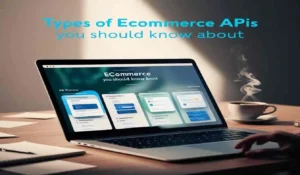Introduction To Ecommerce API
Ecommerce APIs are vital tools to support the functions as well as integration with your ecommerce platform . An API enables an easy communication among software components, improving the overall commerce experience. No matter if you run an unassuming ecommerce site or running a large online retail store, the APIs enable developers to build specific solutions. They let businesses build ecommerce features that meet specific requirements. Nowadays, ecommerce websites use APIs to enhance everything from the processing of payments to customer interaction which can boost efficiency and create new ideas.
Understanding the Basics of Ecommerce APIs

Knowing the fundamentals of APIs for e-commerce is vital for any company looking to succeed in the online market. These powerful tools, also known by their acronym Application Programming Interfaces, act as intermediaries, allowing various software systems to interact seamlessly.
APIs are the basis for integrating different services on your eCommerce website and enhancing the user experience and functionality.
Through facilitating connections between various systems, including payment gateways as well as the marketing automation APIs developers can build an even more efficient and cohesive platform. This connectivity does not just streamline processes but also allows businesses to draw insights from data-driven analysis and tailor customer experiences that ultimately drive expansion and innovation.
What are Ecommerce APIs and How Do They Work?
Imagine this: you’re at an international market and everybody is speaking different languages. Chaos, right? Imagine having a universal translator which allows each customer and seller to seamlessly communicate. This is exactly what an ecommerce API can do with regard to the online shop you have.
API is the abbreviation of Application Programming Interface. In simple terms, it’s an arrangement of protocols and rules which allow various software applications to communicate with one another. Ecommerce APIs have been specifically developed for platforms that sell online that allow users to share information and functions seamlessly with other systems.
Imagine APIs as the helpful waiters in any restaurant that you like. They will take orders (request) and transfer them to your kitchen (server) and then deliver your delicious food (response). In the world of online shopping this might mean obtaining information about products, processing payments or updating inventory on several platforms.
Types of Ecommerce APIs You Should Know About

After we’ve got the basics covered Let’s get into the various types of APIs for ecommerce. It’s similar to walking into an ice cream shop – there’s an option for everyone’s taste!
- Product Information APIs These APIs are the information engines, providing complete information on products, including descriptions, prices, as well as availability.
- Order Management APIs Imagine these as your online order processing ninjas. They handle all aspects of order processing from creation through fulfillment.
- Pay Gateway APIs The safe payment processors in the API world, providing secure and seamless transactions.
- Inventory Management APIs They ensure that your inventory levels are within control across all of your channels of sales, and prevent the dreaded “out of stock” messages.
- Shipping APIs The lifesaver for your logistics with real-time shipping rates and tracking details.
Integrating APIs for Ecommerce into Your Platform
Integrating APIs for eCommerce to your platform is an transformational process that will improve the efficiency of your company. A properly implemented API allows seamless integration between different components, increasing capabilities and user experience. For instance the check-out API could simplify the process of paying for purchases and allows developers to create user-friendly efficient and effective systems. Making use of APIs to enhance user experience is vital in the current competitive marketplace since an efficient integration of e-commerce will ensure smooth operations and a positive customer experience across all channels.
Benefits of Using Ecommerce APIs
Integrating APIs for ecommerce in your platform is like the online shop you run superpowers. What do these powers actually mean? Let’s take a look:
- Increased Efficiency APIs help make repetitive chores easier, allowing your time to concentrate upon growth strategy.
- enhanced customer experience Provide up-to-date information and individualized services that keep your customers satisfied.
- Scalability You can easily add new features and functions as your business expands.
- Competitive Edge Keep ahead of the pack by swiftly responding to market trends and the needs of customers.
- Cost-effective reduce development costs by using existing APIs instead of creating everything completely from scratch.
How Ecommerce APIs Improve Customer Experience

A happy customer is the lifeblood of any e-commerce company that is successful. What is the best way to APIs help to improve satisfaction of customers? Let’s explore!
Read this useful article: E-Commerce Logistics: 6 Secrets to Boost Efficiency
Ways Ecommerce APIs Can Enhance Your Ecommerce Business
- Personalized Recommendations Utilize APIs to study the data of customers and provide customized product recommendations.
- Continuous Omnichannel Experience Give consistent information across all platforms from your site and mobile app.
- Actual-Time Updates on Inventory No more unhappy customers because of out-of-stock items.
- Quicker Checkout Process Incorporate payment gateway APIs to facilitate fast safe transactions.
- Enhanced customer support Utilize APIs to give instant access to information about orders and status changes.
Utilizing Ecommerce APIs to Streamline Operations
Utilizing APIs for e-commerce is essential for companies seeking to improve their operation. An API permits various systems to communicate efficiently by eliminating the need for silos and increasing efficiency. The integration of the Shipping API can streamline logistics, thus reducing delivery time and expenses. In addition an API for marketing automation market automation API will allow you to personalize your customer’s interactions, increasing the engagement of customers and converting. The most effective e-commerce APIs serve as a dynamic layer on top of the e-commerce platform and facilitate seamless workflows while allowing companies to react quickly to market shifts.
Integration and Implementation of Ecommerce APIs
Integrating APIs into an e-commerce platform could be as difficult as learning how to balance on a unicycle. However, don’t be afraid! If you follow the correct method, it’s as silky smooth as silk. Here’s a close-up perspective of the process:
- Determine Your Needs What specific functions are you seeking to include or enhance?
- Select the appropriate APIs Choose and research APIs that meet your needs.
- Create the Integration Plan the Integration: Determine the ways that APIs integrate with your current systems.
- Implement and test Integration of APIs, and test thoroughly for any problems.
- Monitor and optimize Monitor performance continuously and make the necessary adjustments.
Step-by-Step guide to integrating APIs for ecommerce with Shopify

Let’s take a look with a concrete illustration. Shopify is among the most popular e-commerce platforms using APIs, and integrating it can boost the performance of an online shop. Here’s the step-by-step process:
- Create an Shopify Partner Account This will grant access to API credentials.
- Create API Credentials Access your API secret and API key from the Shopify administrator panel.
- Select your API Endpoints Select which Shopify API endpoints require (e.g. Customers, Orders, Products).
- Set up authentication Utilize OAuth to authenticate API requests.
- Make API calls Begin making calls to Shopify API to fetch or change data.
Integrating Product Data Using Ecommerce APIs
A very popular uses for APIs from e-commerce is the integration of product data. Here’s how to achieve this:
- Fetch Product Information Use Shopify’s API for Product Data to retrieve information about products. Shopify Product API to retrieve details about the product.
- map the data align the API data to the schema of your database.
- Change Your Database Save the information you have fetched within your system.
- Set up Webhooks Utilize Shopify webhooks to receive real-time updates whenever the information about your products changes.
Automating Ecommerce Processes using API Integration
Automation is the norm in the world of e-commerce today. APIs can be your key to automating different processes, thereby saving time and reducing the chance of errors. Here are some of the processes you can automate
- Inventory Management Automatically update the stock levels across all channels of sales.
- Delivery Fulfillment triggers automatic order processing and the generation of shipping labels.
- Customer Data Sync to keep customer data identical throughout all the platforms.
- Price updates The system automatically adjusts prices in response to the data of competitors or market conditions.
Maximizing the Potential of Ecommerce API Economy
maximizing the benefits of an API for e-commerce economy requires using sophisticated API capabilities to create new ideas. For example, the Shopify Storefront API and HubSpot’s Ecommerce Bridge API demonstrate the way in which an Ecommerce API helps to facilitate seamless integration. This API allows companies to streamline their processes through changing data into valuable business information, which improves the efficiency of decision-making. These tools are unbeatable in their speed, allowing businesses to succeed in a digital age.
How Ecommerce APIs Enable Innovation and Growth
The e-commerce API market is like a thriving landscape, full of opportunities for growth and innovation. When you leverage APIs, you’re not only making your existing operations better, but you’re creating entirely new possibilities. Here’s how:
- Rapid prototyping Test quickly new business models or features without a large investment.
- Ecosystem Extension It is easy to integrate with complementary services to give greater value to your clients.
- data-driven decisions Analyze and access data from various sources to make informed business decisions.
- new revenue streams Create and sell your own APIs to create new income streams.
Optimization of your Online Store by utilizing Ecommerce APIs

Optimizing your online store by utilizing Ecommerce APIs will significantly improve the performance of your site and improve customer experience. These APIs function by linking and synchronizing components, including your catalog of products or order-management systems. Utilizing tools such as those of the Amazon API, ecommerce websites make use of modern technology to improve their operations. APIs are a great way to streamline your operations. API lets to manage inventory effectively, while developers can develop applications to improve the functionality of your site and increase customer engagement. With APIs, you are able to create e-commerce products that are reliable and expandable.
Utilizing Multiple APIs to Enhance Ecommerce Operations
In the e-commerce world of APIs, more can be the better. By combining several APIs you are able to build an incredible set of functions. Here’s how:
- Create an Unified Dashboard: Integrate analytics APIs into your e-commerce platform to get an overall view of your company.
- enhances Product information Use APIs of the product with review APIs for detailed, informative pages for products.
- Enhance Price Utilize price APIs of competitors along with your inventory API to create flexible pricing strategies.
- Enhance Customer Service Integrate chatbot APIs into the order management software to provide effective customer service.
Conclusion
So there you are You’re all set! We’ve explored the fascinating world of APIs for e-commerce starting with the basics to implementing sophisticated strategies. By following these five steps–understanding, integrating, utilizing, maximizing, and optimizing–you’re well on your way to revolutionizing your retail strategy.
Keep in mind that in the ever-changing environment of e-commerce, APIs are your secret weapon. APIs are the key to increasing efficiency, increasing customer satisfaction and ensuring you stay ahead of the pack. What is your time wasting? Now is the time to take advantage of the power of APIs for ecommerce and see your online store rise to new levels!
FAQs
- Are they secure e-commerce APIs? Ecommerce APIs use sophisticated security measures such as OAuth as well as HTTPS to safeguard information. It is important to adhere to the best guidelines, like regular updates to API keys, and employing the correct error handling.
- Do small-scale businesses gain from APIs for e-commerce? Absolutely! APIs can even the playing field and allow small-sized businesses to use features and integrations previously only accessible to larger businesses.
- What is the best time to refresh my integrations with APIs? It’s best to examine and make changes to your API integrations regularly at least every quarter. This will ensure that you’re taking advantage of the latest features while keeping your security.
- What is different between the REST API and GraphQL APIs for e-commerce? REST APIs are extensively used and adhere to an established structure, whereas GraphQL APIs provide more flexibility when it comes to data retrieval. The choice you make is contingent on the specific requirements of your business and the degree of complexity of the data requirements.
- How do I determine the return on investment of implementing an API for ecommerce? Track metrics like increased efficiency in operations, less mistakes made by hand, more sales by personalization, and increased scores of customer satisfaction. Examine these against your API cost to determine the ROI.
